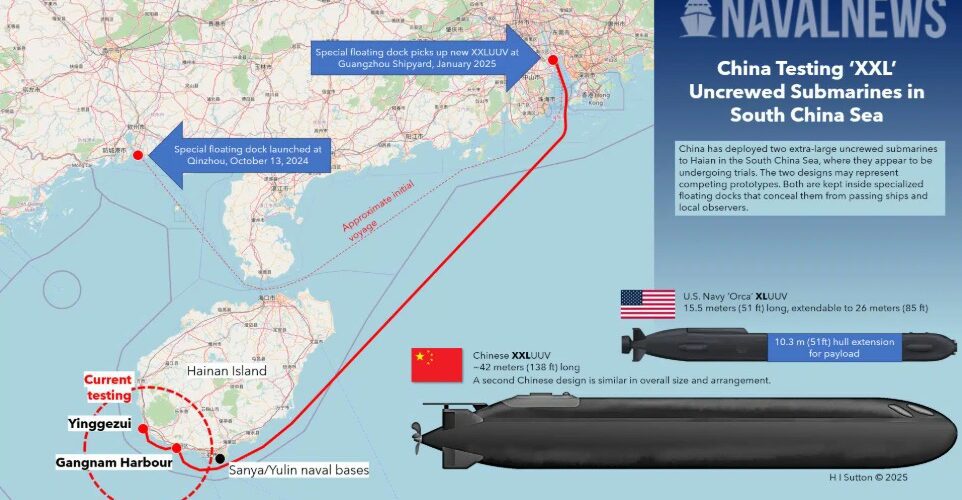According to reports, China has clandestinely deployed the world’s largest uncrewed submarines to the South China Sea. These are categorized as “XXL” or extra-extra-large uncrewed underwater vehicles (XXLUUVs) and are incomparable to the Western equivalents which may appear tiny in contrast.
They are based temporarily off Hainan Island and display People’s Liberation Army Navy’s (PLAN) determination to control the Indo-Pacific underwater war theatre. Beijing has made no public announcement in regards to this development.
This information came to light through open-source intelligence (OSINT), after reported by defence analyst H. I. Sutton who mentioned their presence in Naval News, supported by satellite imagery and technical deductions. The development has happened at the time when there are already tensions brewing in South China sea and PLAN trying to tip the balance of power in its favour.
The strategic positioning of these behemoths in Hainan will serve as a “forward operating theatre” for Beijing’s most advanced maritime technologies. This also shows China’s tilt towards unmanned systems which may be a cost-effective way of projecting power without exposing its military personnel by lowering the threshold for escalation. This will be worrisome for regional actors like Vietnam and the Philippines, whose technological capabilities may be undermined in presence of XXLUUVs especially in case of underwater blockades.
It is for certain that the Chinese have heavily invested in unmanned underwater vehicles (UUVs) for more than a decade. This puts it ahead of the United States and its allies in terms of scale and potential.
China has surpassed Washington’s Boeing Orca XLUUV by carrying out fielded prototypes, tested and tried multiple variants, and now by producing the XXLUUV class. Earlier generations included the Sea Wing glider and the HSU-001 large displacement UUV (LDUUV), which were deployed for surveillance, mine warfare, and intelligence gathering missions.
In 2019 the HSU-001 in paraded at the National Day celebrations in Beijing, showcasing China’s intent to display UUVs as an important part of its naval arsenal.
Hainan Island and shipyards like Dalian and Huludao, have rapidly grown into a centre for submarine and UUV innovation. The Satellite images have also revealed new underwater test structures near Dalian. These are presumed to aid docking and data relay for autonomous underwater vehicles. Specialized vessels, including crane barges and stealthy transport craft resembling the U.S. M80 Stiletto, have been observed helping UUV operations.
China sees UUVs as asymmetric force multipliers capable of intimidating adversaries.
The two new XXLUUVs deployed to Hainan measure between 40 and 42 meters in length. This makes them 10 to 20 times larger than Germany’s MUM (Modifiable Underwater Mothership) or the U.S. Navy’s Orca XLUUV. The vessels lack sails and have X-form stern rudders designed for agility and reduced acoustic signature, optimised for both endurance and survivability in hostile environments.
Their hulls are streamlined, focusing on stealth characteristics and for minimising hydrodynamic drag. Propulsion is believed to rely on diesel-electric systems supplemented by high-capacity lithium-ion batteries. These are smaller than China’s crewed Type-093 and Type-095 nuclear attack submarines.
Each vessel is capable of carrying eight heavyweight torpedoes, naval mines, or long-range anti-ship missiles in modular compartments. They can also deploy multitude of smaller UUVs or unmanned aerial vehicles (UAVs) launched from canisters, enabling multi-domain operations. Sensors are expected to include flank sonar arrays, synthetic aperture sonar, and AI-enhanced data processors capable of fusing information in real time.
One of the XXLUUVs is linked to the 705 Research Institute under China Shipbuilding Industry Corporation (CSSC), known for its role in naval weapons development. Testing is concentrated around Gangmen Harbour and Yinggezui, areas west of the PLAN’s Sanya nuclear submarine base—already a hub for carriers, SSNs, SSBNs, and advanced UUV projects. They could operate as autonomous “arsenal submarines,” carrying torpedoes or anti-ship cruise missiles for covert strikes.
Mine warfare is a particularly likely role, as demonstrated by the AJX002 minelayer UUV also tested near Hainan. The other expected role of these vessels may be assumed to be long-range intelligence, surveillance, and reconnaissance (ISR), linking with China’s “Underwater Great Wall” sensor network for continuous monitoring of U.S. and allied submarines.
More on China:
Amid rising trade tensions with the US, a growing coalition of BRICS nations is banding together to counter Washington’s tariff threats: https://www.thestrategicperspective.org/brics-nations-band-together-against-washington-tariff-threats/
Zangnan: the place in Arunachal Pradesh, which China claims: https://www.thestrategicperspective.org/zangnan-between-the-chinese-dragon-and-the-indian-lion/
The Harbin Z-21 attack helicopter represents a significant development in China’s military aviation capabilities: https://www.thestrategicperspective.org/china-tests-harbin-z-21-in-tibet/
India’s missile programme aiming homeland security amid rising China capabilities: https://www.thestrategicperspective.org/indias-substantial-missile-programme/
India’s air warfare capabilities closely watched by China:
https://www.thestrategicperspective.org/aerial-surveillance/
China’s long strategy, where peace is not an objective: https://www.thestrategicperspective.org/chinas-2049-plan-a-big-challenge-before-the-world/











